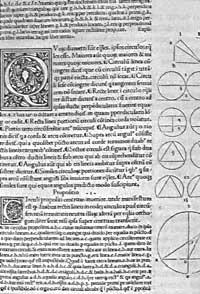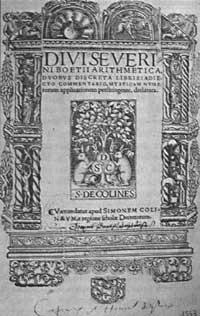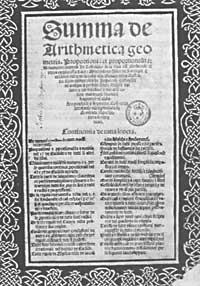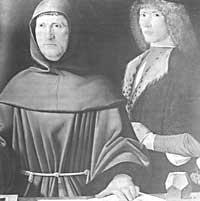Renaissance mathematics

At the beginning of the Renaissance a lot of work was done in the field of mathematics. In this elaboration the medieval collections were based. The true development of mathematics, that is, the system constructed by deductions through logically formed propositions, disappeared during the Middle Ages and was only used to perform the calculations necessary for commercial mathematics exchanges, for land measurement, etc. But XIV. Due to the boom of commercial life in the nineteenth century, the calculation required a new deepening that forced to recover, investigate and deepen medieval collections.
The most prestigious Latin collector is Boecio (475-524). He wrote several simple treatises on astronomy, geometry, arithmetic and music based on works by Ptolemy, Euklides and Nicholas of Alexandria. But more important than these is their translation of writings on Aristotelian logic. The other collector to consider is Kasiodoro (~ 490-580). In the “Etymologies” of San Isidoro (570-636) of Seville you can find definitions of mathematical concepts such as the Veda Venerable (673-735) or the Alcuinus of York. XII. In schools that in the mid-twentieth century were linked to several European cathedrals, the works of these collectors mentioned in the project “quadrivium” (geometry, astronomy, arithmetic and music) were considered as texts.
But, as we mentioned before, in the development of mathematics this path is not so important, but the second. The most fruitful benefit of the Arabs to scientific thought was the recovery and transmission of classical Greek science, and despite its low original result, its secular and open attitude towards science, against the Western, was a great advance.
The Arabs drank classical Greek science from two sources: on the one hand, it is the source of the Greeks of Bizantzio and, on the other, that of the Nestorian Christians located in eastern Persia. Although the Arab sciences return and retain Latin XII. century IX. We know that by the 20th century there were several translations. From this last century the commercial relations between Christian Europe and Islam multiplied and the rest of the relations. Thus, Arab translations found their way to the west. Sicilia and Toledo became the translator's booth. Of course, these translations were made from Arabic to Latin. But XII. Direct translations began in the 19th century, that is, from Greek to Latin. Year after year this road was taking priority and the XIV. At the beginning of the 20th century Arab translations were very little used.
What the Arabs transmitted west in the field of mathematics was much more prosperous than what Greek science had. This wealth does not correspond to the original work of the Arabs, but to the assimilation of Hindu mathematics. The Hindus made great strides in the field of arithmetic and algebra: they knew square and cubic roots, had the means to make sums of intentional geometric arithmetic series, had methods of solving primary and secondary equations and had the trigonometric table of the sine.

However, the greatest gift they made to science was their numbering system, that is, the positional system we use now and in which the invention of zero deserves a special place. First complete declaration of this system IX. In the 18th century it was done by an Arab mathematician named Al-Khwarizmi. In the West the expansion of this system was very slow and although XII. 16th century. In the 18th century (except in Italy) the Roman system was widely used in other territories. However, XIV. It can be said that from the 20th century the Hindo-Arab system was imposed among mathematicians.
The development of mathematics at this time developed in the West in three steps. The initial can be called “the first Renaissance”; XIII and XIV. It happened for centuries and its main achievement was the recovery of classical mathematics. He had his own cabin in Paris. His most quoted person is Leonardo de Pisa and his main area was arithmetic or calculation. Second part XV. We have it in the 20th century. On this occasion a new chemist of mathematics managed to flourish, that is, algebra and its top were published in 1494 the work “Summa” by Luca Pacioli. From now on, the development of mathematics will follow the arithmetic - algebraic line, with which we are in the elderly, that is, in the Renaissance.
As has been said, the main branch of mathematics of this time was algebraic arithmetic, but we must also recognize the advances in both geometry and trigonometry. The truth is that there were no important theoretical advances in the field of geometry, but we must take into account the works made by architects, painters, etc. The particularity of this era is the development of the scientific-technical spirit. Therefore, the practical advances of any discipline meant more than just a technical aspect.
On the other hand, trigonometry achieved a breakthrough at this time and achieved all its autonomy. Thus, the one who at the beginning of that time was only a miracle of astronomy, at the end will be its owner.
Therefore, the door to its theoretical development was opened in the coming years.
Life of Viète XVI. It ended in the twentieth century, but in his work is the basis of the leap that must be made to pass to symbolic algebra. This closed a period of great importance in the history of mathematics. Almost immediately the impulse of the new physics made the infinitesimal calculus prevail in the field of mathematics. We can end a stage. Its results would begin to flourish in the following century, that is, at present, Modern Science or the XVII. With the beginning known as Scientific Revolution of the twentieth century.
Teaching Mathematics

XII. Until the 20th century the intellectual world was imprisoned in monasteries. This situation began to deteriorate in the aforementioned century and with the creation of universities. This is the case of Paris (1160), Bologna (1160), Oxford (1167), Padua (1222), Salamanca (1227), Krakow (1364) and Vienna (1367). University education was based on seven liberal arts and in science the “quadrivium” was the meeting place. Although in the beginning universities are of great help to the intellectual world, when they reached the Middle Ages they became castles of the defense of the Aristotetic-Christian tradition, affecting only scientific developments.
The level of mathematics taught in universities was very low and remained in that situation. Until the end of the 20th century. In fact, XIII, XIV and XV. Advances in mathematics made in the 19th century were made outside universities. So, XV. The universities that taught mathematics in the second half of the 20th century were only in Bologna and Krakow, where they taught for supporting astronomy and astrology. With the turn of the century, the situation changed radically. XVI. In the 20th century, mathematics chairs began to flourish in all universities.
In the development of mathematics (and not just mathematics) the printing of books was especially important. This, among other things, generated and accepted the unique and simplest symbolism, something that, as we all know, is essential for the development of mathematics. At this beginning, the first work was the publication of classical writings. Thus, in 1472 the “Etymologies” of Isidoro of Seville and the “Sphaera” of Sacrobosco will be printed, in 1478 the “Arithmetic” of Boecio will see the light (which in a century had more than twenty-five publications) and in 1488 would correspond with the “Algorismus” of Sacrobosco. Works by both Euclid and Archimedes, Apollonius and Diofanto will now be published, along with many other classics. In addition, not only in Latin but also in popular languages.
Therefore, the university with its chairs, on one side and on the other the bibliographic infrastructure had columns. For the development of teaching mathematics in the twentieth century.
Towards algebra calculation
XIII. Due to the expansion of commerce and banking in the 19th century, especially in Italy, a series of mathematical works were drafted and published aimed at practical use. Thus XVI. In the 18th century it can be said that practical arithmetic reached the Golden Age.

The first practical arithmetic that was printed was published in Treviso in 1478 and its author is unknown. It includes, among others, the four basic operations (succinctly addition and subtraction, multiplication and wider division and by different means; let us not forget that the resolution of these last operations throughout the Renaissance had its difficulty), the rule of three (“regola de tre cose”), etc. are found. Ten years later, Pietro Borghi will publish his work in Venice. From Italy this trend moves especially to Germany, where several books are published.
In those years the first steps were taken for the collection of an indispensable tool for the creation of mathematics, that is, for the construction of an abstract formalism. Through it, terms and operations would be expressed with a general and simple symbology, facilitating the expansion and deepening of mathematics. Mathematics builds models above ideas, so you need a symbolic code to go straight to the bottom by removing the sheets.
In this field the problem of writing numbers is very important. On the one hand, we have abacerdotes. These were supporters of writing the numbers in Roman and XVII. Until the mid-twentieth century, between bankers and traders, above all, these were the ones who dominated. It should be remembered that the Abbasics used for their operations and have so far been used in Russia and Asia.
Before them we have those we can call algorithmic. These wrote the numbers in Arabic. At first this writing was used only in universities and its expansion process was slow and laborious. One of the most important calculus books with this new writing is the so-called “Algorismus” (1488) by Sacrobosco, mentioned above. But among those who worked mathematics as theoretical sciences there was an opportunity in the Renaissance. Therefore, the Arab numbers got their importance.
Fifteen years after the publication of Treviso’s “Arithmetic”, the imposing “Summa” by Luca Pacioli appeared. The Franciscan Luca Pacioli was professor of Perugia and Rome and in 1494 published in Venice the book entitled “Summa de arithmetica, geometry, proportioni et proportionalita”. This work consists of five sections, each of which is divided into different subsections. The core of the text corresponds to arithmetic and algebra. The first part of the “summa” analyzes arithmetic: the Pythagorean classification of numbers and the traditional theory of regular polyhedra. He will then explain basic arithmetic operations, addition (by one method), subtraction (by three methods), multiplication (by eight methods), division (by four methods), arithmetic progression calculations, square and cubic roots, and waterproofing. He will then investigate the fractions and thus finish the arithmetic.

It provides mnemonic standards to remember basic operations and leveling signs when starting algebra. In this way, it distinguishes between those that should be used in daily calculations and in the “maggiore art” (which it will call “caratteri algebrici”).
He will study first and second in the theory of equations. The highest ranking will say that, in general, it cannot be solved through algebra (some years later would be Tartaglia, Cardano and other mathematicians). In the fourth section it will give us the double heading accounting and monetary and measurement tables, while in the fifth section it deals with geometry.
XVI. Throughout the 20th century, the development of algebra advances by two lines. On the one hand, the construction of a simple and sumatic symbology and, on the other, the resolution of problems of great importance, such as the equations of third and fourth degree, and on the other hand the construction of a formal science. The first line will be taken especially by German mathematicians. The second is Italian. The combination of these two ways, that is, the passage from the particular to the general through a simple and powerful symbology, S. Stevin (1548-1620) Dutch and F. It will be achieved by the Frenchman Viète (1540-1603). These two scientists are outside the traditional Italian and German schools.
Simon Stevin or Simon de Bruges, one of those late Renaissance scientific engineers. In addition to being a great enthusiasm in solving practical problems, he made his powers move to the theoretical ground. He dealt with the construction of fortresses and docks, but did not rule out geometry, static, hydrostatic, accounting, arithmetic and algebra. His two most prolific works on mathematics were published in 1585 in the city of Leiden. Their names are “De Thiende” and “L’Arithmetique et la Practique de la Arithmetique”.
The first was written by Stevin for practical uses. Although fractions were known before, their use was very small and no one included them within a structure. Stevin invented a new writing in order to use with fractions the mathematical rules that guide integers. However, this writing was not very adequate and within a few years (1617 o) Neper proposed to write the decimal part separated by a comma after the integer we currently use. In this work, the decimal base system of weights, measures and coins proposed by the author should wait more than two centuries to take shape.

Arithmetique presents two ideas of great importance for the development of algebra. On the one hand, the sum of the concept of number and, based on this, the sum of the rules of resolution of algebraic equations. Thus, the investigation of the theory of numbers will imply full acceptance of negative numbers and, therefore, eliminate the existing subdivision to solve algebraic equations by offering a “single rule”. However, in the case of cubic and bicarated equations he did not get what he could, since Bombelli (1572 o) had not assimilated the concept of imaginary numbers represented for the first time.
François Vièt revolutionized the vision of mathematical thought. He proposed that calculations are not based on specific amounts but on symbols or symbols that can express any amount. And also get it. Thus, at the level of abstraction, he placed algebra above arithmetic and systematically used algebra in the fields of trigonometry and geometry. In the works of Vièt the passage from the particular to the general is seen for the first time without lips.
Trigonometry
This field was treated as a special part of mathematics in the Renaissance. The manager was Johannes Müller (1436-1476), better known as “Regiomontano”. His work “De triangulis omnimodis libre quinque”, although made in 1465, was not published until 1533. The first two of these five books correspond to the launa trigonometry and the other three to the spherical one. The truth is that although their work is not very original, the new research pathways that open their synthesizing aspects are not exclusive.
Along with other names in this area, Johannes Werner (around 1528), Petrus Apianus (1495-1552), Gemma Frisius (1508-1555), Georg J. Rheticus (1514-1574) and Willerbrord Snell (1581-1626).
Geometry
The Geometry of the Renaissance is eminently practical. Its workers will be mainly painters, architects and craftsmen. In general mathematics books there will be very few pages (in most cases some problems that are put in the final part) and occasionally comes a semi-systematic expression or another. Translations and comments of works by Euklides, Apollonius and Archimedes. The forces spent throughout the 20th century remain in the last scientific humanism. To make a strong leap prior to this field of mathematics, modern physics will have to be completed, but what we already know as Renaissance was already past.





